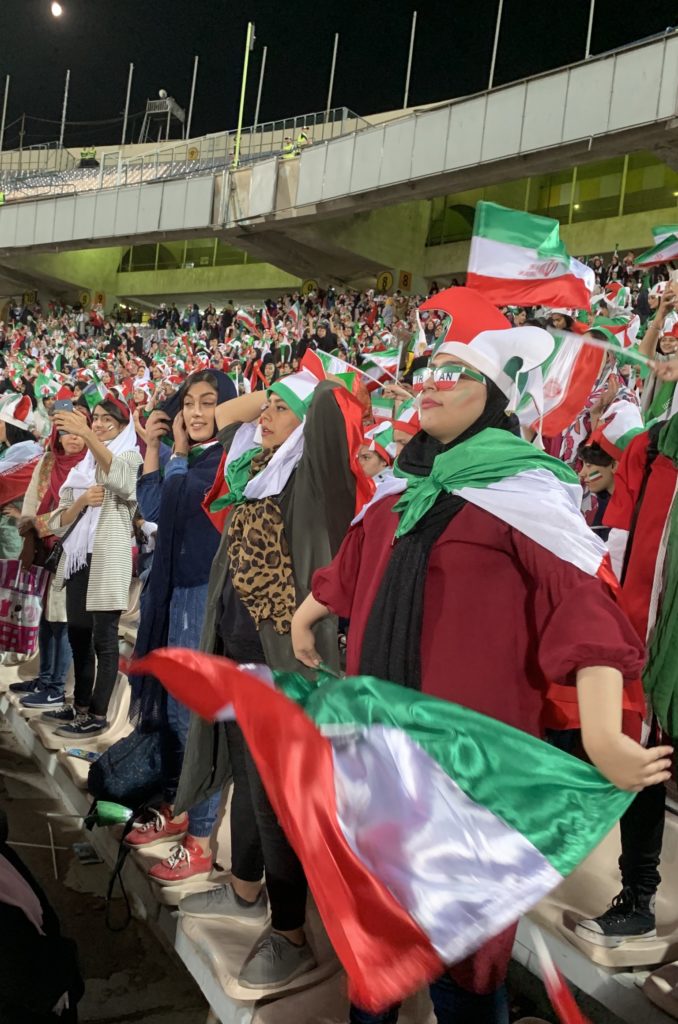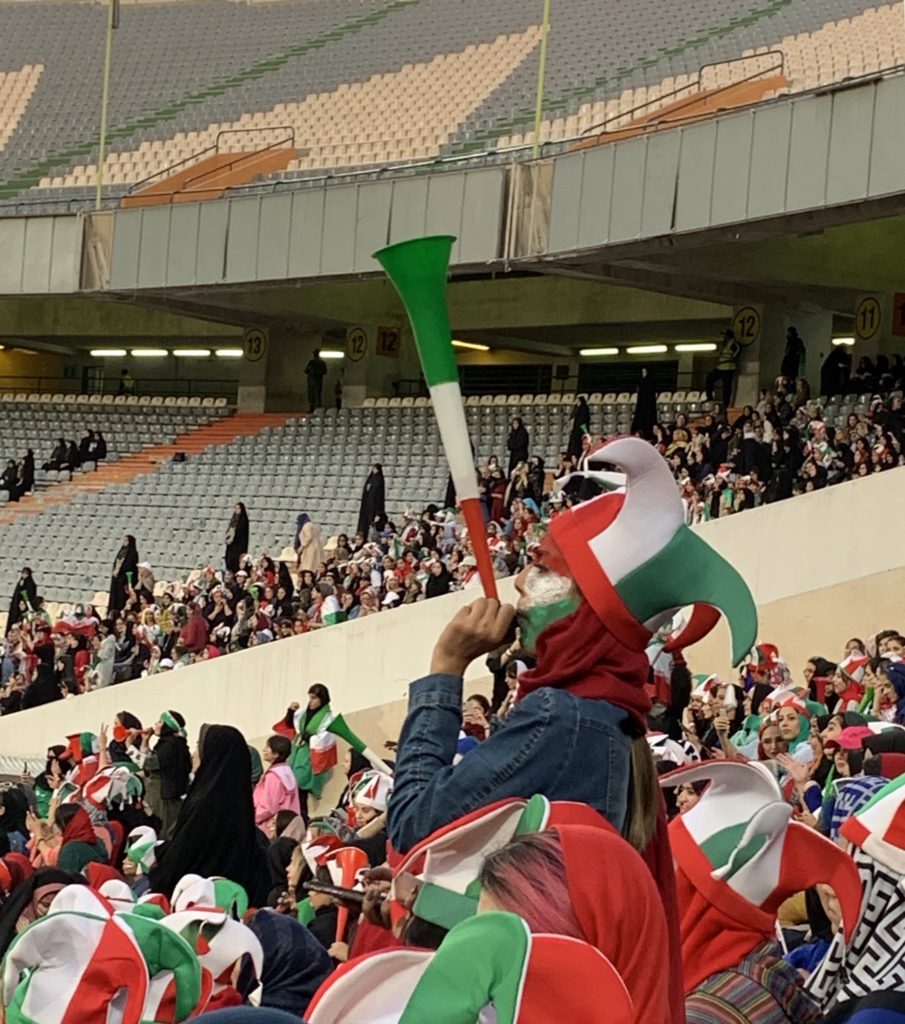For the Iranian women who were there, Thursday, October 10, 2019, will go down as an important date in their country’s history. For the first time since 1981, female fans officially entered the Azadi Stadium in Tehran to watch a football match.
FIFA qualifiers don’t usually attract much interest. But, as if to welcome the women to the stadium, Iran beat Cambodia 14-0. Despite the action on the field, the women in the stands were the centre of attention. At last count, nearly 6,000 women attended.
It was also a momentous event for millions more – Iranian women and men, following the game on social media. Making the moment even more compelling for people watching was the fact that despite limited seating for female-only sections, the number of women exceeded the number of men who came to watch the game.
Azadi Stadium is the biggest in Iran, but it was almost empty. The relatively small number of men who bought tickets for the Iran-Cambodia match seemed mainly to be there to celebrate the first time women were present with the blessings of the government. To show their support for female football fans, many of them posted selfies on social media with the background of female spectators in the distance. When the match ended, male spectators even pointed to women’s sections and directed the Iranian national team to cross the pitch and greet the women at the other end. This was the most emotional moment of the event for the women in the stands; there was a collective feeling of being appreciated and seen.
For the Iranian women who were there, Wednesday, October 9, 2019, will go down as an important date in their country’s history. For the first time since 1981, female fans officially entered the Azadi Stadium to watch a football match.
Uncertain Start: The game started at 5 pm but women had been instructed to be there four hours early. There was a heavy police presence at the eastern side of the Azadi Stadium. So heavy, that the women there began to worry that maybe it wasn’t going to happen after all.

Everyone held their breath and was stressed out. In the back of their minds, there was the reality that all previous attempts by Iranian women over the last 15 years to get into the stadiums were repelled. The worry seemed valid. Just a few days before the Iran-Cambodia match, a group of hardliners demonstrated in front of the Iranian Parliament, opposing the government’s decision to allow women to attend.
At the time, despite having tickets, female spectators were worried that something unexpected could derail their moment.
The carefully coordinated security arrangements led to a 30-minute delay in opening the gates. Ticket-holding women were then directed to a segregated section of the parking area outside the stadium. They were driven in buses from there to the main entrance to the field. During the ride, women were briefed with clear instructions about what they could and could not do during the event.
Any mention of the ‘Blue Girl’ was strictly banned. Iranian authorities preferred to overlook the attention and enthusiasm that the 29-year-old woman’s suicide injected into the Iranian women’s open football stadiums campaign. Sahar Khodayari, dubbed the ‘Blue Girl’ for her favourite team, Esteghlal’s colours, committed self-immolation in early September, after her trial for attempting to enter the Azadi Stadium disguised as a man was postponed.
During what was a short trip from the main gate to the stadium, women in the buses were made to understand that there was a necessity to carefully control the narrative about the historic occasion of which they were a part. Religious hardliners could not be given any reason to turn back the clock. Stadium gates cannot remain open if female fans use the stands as a platform for any kind of protest. For the same reason, at the entrance to the tunnel leading into Azadi Stadium, dozens of female police officers conducted body checks for political signs.
Everyone held their breath. In the back of their minds there was the reality that all attempts by Iranian women over the last 15 years to get into the stadiums were repelled. The worry seemed valid.
Women United: Before entering the stadium, the first women to buy tickets for a football match in the Islamic Republic of Iran, were excited but also anxious. Going through the dark tunnel of the stadium after the security check, with every step forward, the anxiety abated and the excitement endured. Emerging from the tunnel, eyes opened to the field’s large lush green turf. In the stadium, female police officers were standing at every row, helping women to their seats, guiding longtime fans, who, until this moment, knew nothing about their country’s main football stadium.
However, the women were fast learners. Almost as soon as they found their seats, they began chanting and cheering, and the game had not even started.

Almost everyone had a symbol of Iran’s team like a flag, a hat or a horn. They drenched the grey stadium seats in the cheerful and vibrant colours of their team. Covered in the green, white and red of Iran’s flag, women forgot about their differences and celebrated their coming together. Many women in traditional chadors sat alongside others barely able to keep the scarves on their heads.
Throughout the match, journalists on the field had their backs to the match and their cameras pointed at the women’s section. It was perhaps the first time in Iran that football fans were more important than football players on the field.
What even the most powerful cameras could not capture was what it was really like to be in the female stands that day. The horns were so loud throughout the game, women could hardly hear each other speaking. What they couldn’t say to each other was communicated through the overwhelming joy in their eyes at being able to come together, having a united voice, heard around the world.
Throughout the match, journalists on the field had their backs to the match and their cameras pointed at the women’s section. It was the first time in Iran that football fans were more important than football players on the field.
Even female police officers let their guard down and joined the football fans in their chants, cheering on the Iran side together. It was hard not to wonder if some of the female police officers were perhaps from the moral police brigade. They may even have arrested some of the same women in Tehran’s streets with whom they now cheered in the stands. But, at that moment, the Iran’s social conflicts didn’t matter.
Iran’s national football team gave the female fans 14 goals and 14 moments to celebrate their first time at the Azadi Stadium. Fans hope it’s the first of many, but nothing is certain in Iran when it comes to the issue of female fans attending stadium games, including international and club matches. Everything will depend on how Iran’s government looks at this event, seen as a test case for the future. However, Iranian women have taken a significant first step. Despite tight security and carefully controlled limitations placed on women supporters, the fact remains that Iranian women watched a football match in the Azadi Stadium, whose name is Persian for ‘freedom’.
Maryam Papi is an Iranian scholar based in Tehran. You can follow her on Twitter @maryampapi1